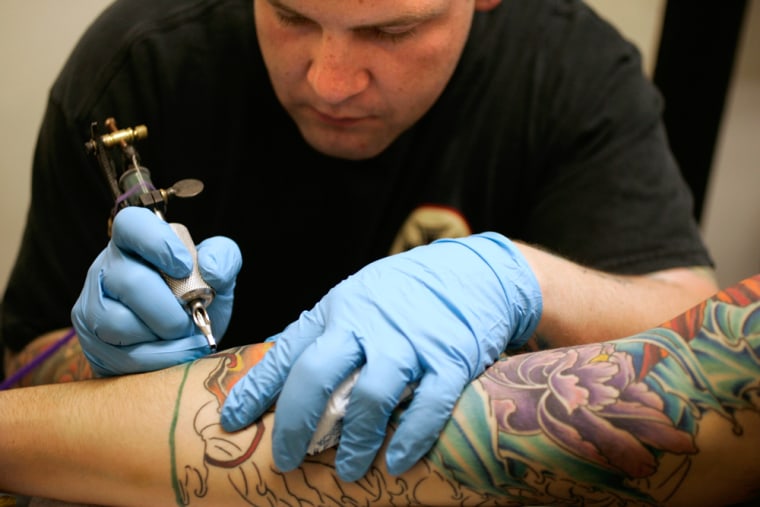A sun shines on Dan Yu’s back, alongside a swimming koi fish. A tree soon may grow on his arm.
“Your body’s an empty canvas, so you almost want to continue to add to it,” said Yu, 28, as he showed off his tattoos.
A generation or two ago, Yu’s tattoos — to say nothing of his pierced nose — probably would have placed him in a select company of soldiers, sailors, bikers and carnival workers. But no longer: The American University employee is among about 36 percent of Americans age 18 to 29 with at least one tattoo, according to a survey.
The study, scheduled to appear Monday on the Web site of the Journal of the American Academy of Dermatology, provides perhaps the most in-depth look at tattoos since their popularity exploded in the early 1990s.
The results suggest that 24 percent of Americans between 18 and 50 are tattooed; that’s almost one in four. Two surveys from 2003 suggested just 15 percent to 16 percent of U.S. adults had a tattoo.
“Really, nowadays, the people who don’t have them are becoming the unique ones,” said Chris Keaton, a tattoo artist and president of the Baltimore Tattoo Museum.
But body art is more than just tattoos.
Piercing popular, too
About one in seven people surveyed reported having a piercing anywhere other than in the soft lobe of the ear, according to the study. That total rises to nearly one in three for the 18-to-29 set. Just about half — 48 percent — in that age category had either a tattoo or piercing.
Given their youth, that suggests the percentage of people with body art will continue to grow, said study co-author Dr. Anne Laumann, a Northwestern University dermatologist.
“They haven’t had time to get their body piercing. They haven’t had time to get their tattoo. They are just beginning to get into it and the number is already big,” Laumann said.
So why has body art become so popular?
Laumann and others believe it allows people to broadcast to the world what they are all about. Others call it sign of rebellion or a rite of passage. The survey found nearly three-fourths of the pierced and nearly two-thirds of the tattooed made the leap before 24.
“It’s a very easy way to express something that you think represents part of your identity — that you don’t have to tell someone but you can just have seen,” said Chelsea Farrell, 21, an American University senior from Albany, N.Y. Farrell has a tattooed fish on each hip and a Celtic knot on the small of her back.
The survey also found that what your mother may have told you about who has tattoos is true: People who drink, do drugs, have been jailed or forgo religion are more likely to be tattooed.
The same holds for piercings, though rates do not appear to vary with education, income or job category. In that sense, they appear to be “different animals,” said Laumann, who has traditionally pierced ears but no tattoos.
One obvious difference is that piercings can be easily removed, unlike tattoos.
“I guess I liked the way they looked and the rush of getting them pierced, as well as them not being permanent. I can take them out and the holes will close up,” said Simah Waddell, 21, of Rochester, N.Y., of her pierced nose, tongue, belly button and ears.
Medical problems with piercings
Waddell, who is entering her senior year at American University, said she suffered no side effects, other than the anger of her parents. The survey suggests that is not always the case for others with piercing. Nearly one in four reported medical problems, including skin infections. Among those with mouth or tongue piercings, an equal proportion reported chipped or broken teeth.
For tattoos, 13 percent of respondents had problems with healing. Generally, the Food and Drug Administration receives few reports of complications from tattoos.
The industry is regulated by state and local officials, but not the FDA, and there is no such thing as an agency-approved tattoo pigment or ink. The FDA is considering more involvement, said Dr. Linda Katz, director of agency’s Office of Cosmetics and Colors.
“If you look at the fact that a quarter of adults have a tattoo, it’s amazing how safe the industry is,” said Dr. R. Rox Anderson, a Harvard Medical School dermatologist and tattoo removal expert. None of the survey respondents had ever had a tattoo removed, though 17 percent had considered it.
Freedom-2 LLC, a Philadelphia company co-founded by Anderson, hopes to launch the first of two lines of not-so-permanent tattoo inks next year, though without FDA approval.
To create the ink, pigments would be encapsulated in a polymer and the microcapsules injected into the skin. A tattoo would be permanent only as long as its wearer wanted it to be.
It would only take a few pulses of a laser to break open the capsules and release the ink into the body to be safely absorbed, said Martin Schmieg, the company’s president and chief executive officer.
A second ink, to be available in 2008, would rely on the same technology, except the capsules would dissolve on their own. Depending on the version, the tattoos would naturally vanish after six months, 12 months or 24 months.
“It will be like wearing a tattoo like it’s jewelry, where you will be able to take it off. It will just fade on its own,” Schmieg said.
The telephone survey on tattoos included 253 women and 247 men and was conducted in 2004. It has a margin of error of 4.5 percentage points.
